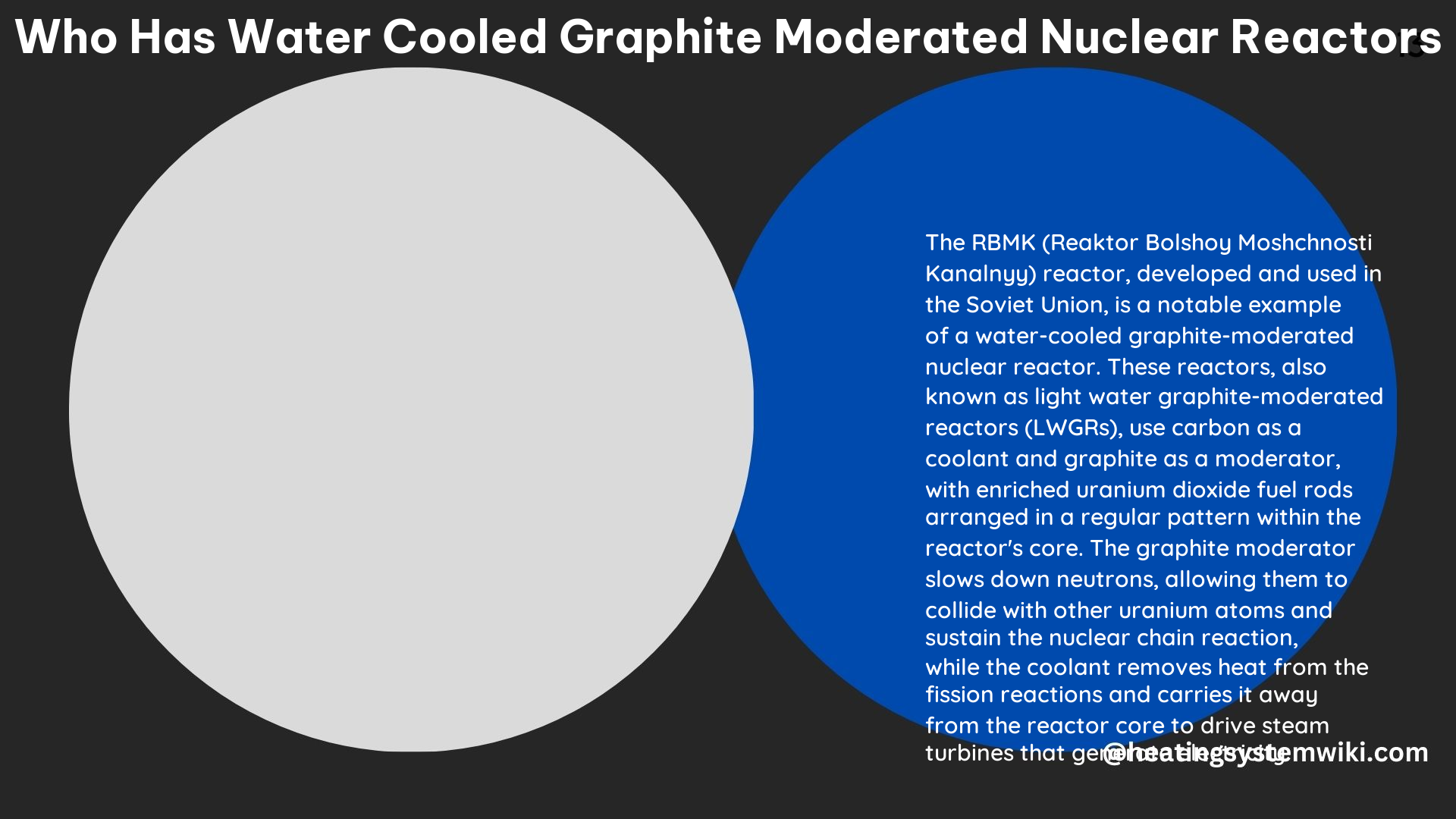Water-cooled graphite-moderated nuclear reactors are used in several countries, including the United Kingdom, Russia, and India. These reactors utilize graphite as the moderator and water as the coolant, allowing for the use of natural or low-enriched uranium as fuel. However, the use of graphite and water in these reactor designs also introduces unique safety considerations and technical specifications.
Advanced Gas-Cooled Reactors (AGRs) in the United Kingdom
In the United Kingdom, the Advanced Gas-Cooled Reactor (AGR) is a water-cooled graphite-moderated nuclear reactor design. Key features of the AGR include:
- Coolant: Carbon dioxide gas
- Moderator: Graphite
- Fuel: Enriched uranium dioxide (typically 2.5-3.5% U-235)
- Fuel Configuration: Fuel rods arranged in a regular pattern within the reactor core
- Graphite Moderator: Allows neutrons to collide with uranium atoms more easily, sustaining the nuclear chain reaction
- Coolant Function: Removes heat from the fission reactions and carries it to drive steam turbines for electricity generation
- Reactor Power Output: Typically 600-1500 MW(e)
The AGR design was developed in the UK as an evolution of the earlier Magnox reactor, with improvements in fuel efficiency, power output, and safety features.
RBMK Reactors in Russia

In Russia, the RBMK (Reaktor Bolshoy Moshchnosti Kanalnyy) is a water-cooled graphite-moderated nuclear reactor design. Key specifications of the RBMK include:
- Coolant: Boiling water
- Moderator: Graphite
- Fuel: Enriched uranium dioxide (typically 2-2.4% U-235)
- Fuel Configuration: Fuel rods arranged in a regular pattern within the reactor core
- Graphite Moderator: Allows neutrons to collide with uranium atoms more easily, sustaining the nuclear chain reaction
- Coolant Function: Removes heat from the fission reactions and carries it to drive steam turbines for electricity generation
- Reactor Power Output: Typically 1000-1500 MW(e)
- Unique Feature: Positive temperature coefficient of reactivity, which can lead to a runaway reaction if not properly controlled
The RBMK design was developed in the Soviet Union and was used in several nuclear power plants, including the Chernobyl Nuclear Power Plant, where a catastrophic accident occurred in 1986.
Pressurized Heavy Water Reactors (PHWRs) in India
In India, the Pressurized Heavy Water Reactor (PHWR) is a water-cooled graphite-moderated nuclear reactor design. Key characteristics of the PHWR include:
- Coolant: Heavy water (D2O)
- Moderator: Heavy water (D2O)
- Fuel: Natural uranium dioxide
- Fuel Configuration: Fuel bundles arranged in a regular pattern within the reactor core
- Heavy Water Moderator: Slows down neutrons more effectively than light water, facilitating the use of natural uranium fuel
- Coolant Function: Removes heat from the fission reactions and carries it to drive steam turbines for electricity generation
- Reactor Power Output: Typically 220-700 MW(e)
- Pressure: Coolant is kept under high pressure to prevent boiling
The PHWR design was developed in India and is widely used in the country’s nuclear power program, taking advantage of the country’s abundant natural uranium resources.
Technical Considerations and Safety Challenges
Water-cooled graphite-moderated nuclear reactors have several unique technical specifications and safety considerations:
- Graphite Moderator:
- Allows the use of natural or low-enriched uranium as fuel, which can be more abundant and cost-effective
- Susceptible to oxidation and fire, particularly in the event of a loss-of-coolant accident
- Water Coolant:
- Can lead to corrosion and erosion of reactor components, especially if the water becomes contaminated
- Requires extensive safety systems and monitoring equipment to mitigate the risks associated with water-based cooling
- Safety Systems and Maintenance:
- Water-cooled graphite-moderated reactors typically have robust safety systems, including multiple redundant cooling systems, emergency shutdown mechanisms, and containment structures
- Rigorous maintenance and inspection programs are essential to ensure the continued safe operation of these reactors
It is important to note that building and operating a nuclear reactor, including water-cooled graphite-moderated designs, is a highly complex and specialized process that requires extensive knowledge, expertise, and regulatory oversight. A DIY approach to constructing and operating such a reactor is not recommended, as it would be extremely challenging and potentially dangerous without the proper training, licensing, and infrastructure.
Reference:
- Nuclear Power Reactors, World Nuclear Association, https://world-nuclear.org/information-library/nuclear-fuel-cycle/nuclear-power-reactors/nuclear-power-reactors.aspx
- Types of Nuclear Power Plants, Sterling TT, https://www.sterlingtt.com/2023/06/07/types-of-nuclear-power-plants/
- Graphite-moderated reactor, Wikipedia, https://en.wikipedia.org/wiki/Graphite-moderated_reactor
